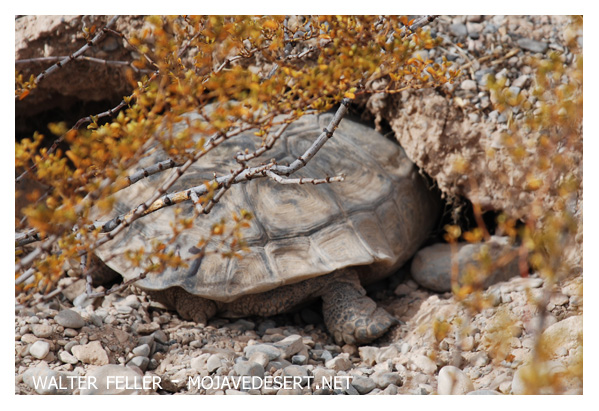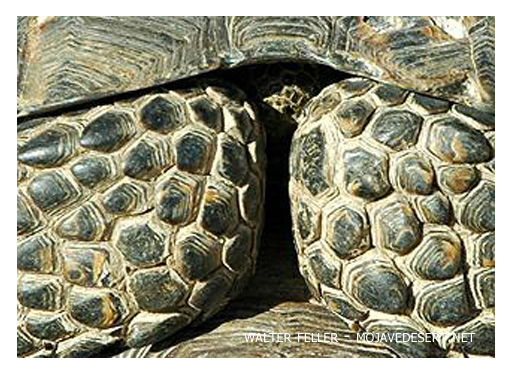Denizens
Testudo, the Desert Tortoise
(Gopherus agassizii)It is interesting to imagine the frame of mind of those early Western travelers who, wholly ignorant of the existence of dry-land tortoises, espied for the first time these queer turtle-like creatures shuffling clumsily across their trail. We can almost see them "glowing" like old Tam, himself, "amazed and curious," and rubbing their eyes twice, then once again, to make themselves sure that tortoises in a desert wilderness are things of reality and not the apparitions of a dream. To their minds tortoises must have always been reptiles closely associated with water, and to find them here in the arid deserts far away from even a suggestion of dampness must have seemed a most extraordinary sight if not an anomaly. When their travels had carried them well within the range of this remarkable chelonian, these immigrants must soon have seen a sufficient number of them to feel assured that the first ones they saw were neither luckless strays from some water-hole nor wayfaring turtles homeward bound to the ocean after a race with the desert hares; for in those days Agassiz tortoises were plentiful all over both the Colorado and Mohave Deserts and in southern Nevada.

Generally these tortoises are found on the flat plots of ground of the high rocky mesas where a fair abundance of succulent, growing herbs assures them of an abundant food supply, at least during the spring season. During April and May, when both days and nights are balmy and warm, they are out feeding at all hours. Often when traveling at night I have seen them by aid of the brilliant moonlight. As soon as the real blistering days of summer come, not a tortoise can be seen by day. No animals except a few of the insects and lizards can stand the intense heat radiated then from the glaring rocks and sands and soda flats. At a point near Amboy on the Mohave Desert the temperature has been known to be as high as 136° F. in the shade at midday, falling to only 114° F. by two o'clock the morning following. A special thermometer placed in the open sun recorded a temperature of 249° F. To be out under such conditions is literally to be cooked alive. The tortoises are wise enough to be under the rocks and bushes then and to confine their feeding to the night hours. Sometimes in summer they pass into a state of dormancy and do not eat at all.
In late October and early November, when the nights begin to get snappy, they begin to "hole up," as the desert people say, seeking the shelter of the ground for the winter's sleep. Tortoises found in winter are numb and seemingly lifeless. Strange it is, but they do not then have their heads drawn in under the carapace for protection. The eyes are closed, and nothing but heat will arouse them.
 Desert tortoises, like turtles, are always slow
of foot, and when approached they seem to
know immediately that the best thing to do is
to stop abruptly and draw in their heads and
feet. In this latter act they are remarkably and
almost ridiculously quick— so quick, indeed,
that they give no creature the least chance to
injure them. As the head is drawn in, they
forcibly eject through their tiny nostrils the air
from their lungs and so produce a rather alarming hiss. Securely encased in their shells, like
non-resisting Quakers they wait in quietness
and find safety in passive resistance.
Desert tortoises, like turtles, are always slow
of foot, and when approached they seem to
know immediately that the best thing to do is
to stop abruptly and draw in their heads and
feet. In this latter act they are remarkably and
almost ridiculously quick— so quick, indeed,
that they give no creature the least chance to
injure them. As the head is drawn in, they
forcibly eject through their tiny nostrils the air
from their lungs and so produce a rather alarming hiss. Securely encased in their shells, like
non-resisting Quakers they wait in quietness
and find safety in passive resistance.
To the Piute and Shoshone Indians inhabiting the Great Basin the economic importance of this dry-land "turtle" was considerable. These native people, who knew no natural repugnance to the use of lizards and snakes as food, used tortoises freely, as the great numbers of "shells" found around their old campoodies show.
To-day many of them are caught by the whites and cooked up into soups and stews, and one may occasionally find the savory meat offered on the tables of small-town restaurants of the desert.
In so far as I can learn these remarkable chelonians have, besides man, few enemies. The foolish coyotes, hunger-bent, sometimes make dolts of themselves by attempting to get inside the shell. Many a tortoise bears on his shell the toothmark-record of an encounter with these wild dogs of the deserts. I am not quite so sure but that a coyote might make a wretched meal off a soft-shelled baby tortoise, swallowing it half-chewed like an oyster, but as to getting a feast out of one of the hardcarapaced adults, I am more doubtful. It seems he might as well chew rocks. We can well fancy the chuckling sense of pleasure the tortoise, knowing his safety, has when he finds himself rolled over and over and pawed about by the foolish dog simpleton, or feels the long sharp-fanged canine jaws harmlessly biting, but never making more than a mere impression on the hard-shelled armament. We can with imagination's aid see the outwitted coyote finally leaving the tortoise in disgust and yowling in similar vein to the foolish fox who unsuccessfully attempted to rob the vineyard, "Oh, I never did like tortoise meat, anyway."
But though the chelonian has been unharmed by the coyote's jaws, woe may yet overtake him if by some unhappy chance the coyote on departing should have left him lying flat on his back on some perfectly barren level spot: his end must now be death through starvation and exposure. The shell of his back is so highdomed that, struggle as he may, he cannot get his clumsy feet to the ground to turn himself over. Had he been so fortunate as to have been turned upside down on some place where tall grass or tufted herbs were growing, there might have been a chance for him. An extra long stretch and twist of the neck and a bit of tortuous struggling with the elephant-like rear feet would under these circumstances have put him over.
 How does Gopherus get his water? Watch
him in the early morning after a rain when
there are droplets of water or dew on the herbs,
and you will see him nosing up to them and
catching the dangling water pearls in his horny
beak. However, like his fabled racing competitor,
the hare, he gets most of his moisture from
the herbage he eats.
How does Gopherus get his water? Watch
him in the early morning after a rain when
there are droplets of water or dew on the herbs,
and you will see him nosing up to them and
catching the dangling water pearls in his horny
beak. However, like his fabled racing competitor,
the hare, he gets most of his moisture from
the herbage he eats.
It is always a matter of speculation when we attempt to give the age of an adult specimen. A tortoise grows so slowly that it is almost impossible to see any change in size in any single year. The largest ones measure fifteen inches or more across and are doubtless very old. How many times have I wished, as I have seen these venerable creatures gazing up at tne from out their brown-irised eyes, that the dumb mouth could speak and tell me of the things that have come to pass during their lifetime in their big wilderness world.
Tortoises make excellent pets. Give them but an out-of-the-way corner of your lawn and they will stay with you for years, content on such humble fare as lettuce and Bermuda grass and asking nothing of you but the sufferance to live. And why should we not learn something from these little dumb brothers of ours? Nature has withheld from them the gift of expression, but they may speak to us just the same, teaching us simplicity, humility, and gentleness.
There is a certain nobility of form and demeanor about these beautiful chelonians that has always appealed to me, and it is always with a sense of sorrow that I see them carried off and piteously slaughtered. Several times I have seen them piled by dozens in great crates and ruthlessly taken to the city markets, there to be butchered to satisfy the gormandizing epicures who can afford and will pay such fancy prices as this meat brings. Like lobsters the poor things are thrust into boiUng water (sometimes in cold water and then brought to a boil) — a practice which must elicit the sympathy of any one who has any sense of pity for God's sentient creatures.